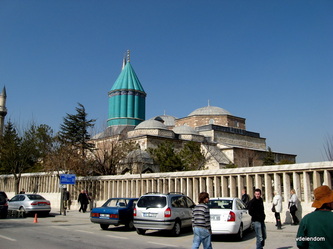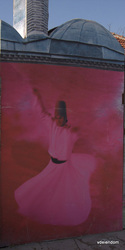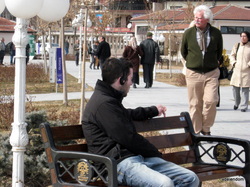Konya is an important pilgrims’ destination for Sufi Muslims. This is where Rumi, a Sufi mystic spent most of his life and where his burial site is. It is Friday – Day of Prayer and important religious day of the week. The city is bustling and there is a feeling of excitement in the air. Men with black suits, women, elegantly dressed in their traditional attires, and children are out on the streets.
We are allowed to go into the mosque during the time of prayer. With our shoes off, and my hair covered, we enter and quietly sit down on the carpet. The imam is giving his message in Arabic. Men are allowed in the main prayer hall whilst women have to go to a specific area “out of sight.” I therefore feel very out of place and squeeze myself into the wall at the back. It appears as if a specific time to arrive is not important, because people come and go all the time during the service. We don’t stay too long and then go to the Rumi Memorial Museum, the former lodge of the Whirling Dervishes (Dervish: from Persian is someone treading a Sufi Muslim ascetic path or “Tariqah, known for their extreme poverty and austerity, similar to mendicant friars in Christianity or Hindu/Buddhist/Jain sadhus) and also where the tombstone of Rumi is. It is considered a very holy place by the Sufi Muslims – no photos or videos are allowed once you are inside. The mausoleum is crowned by an imposing turquoise dome that dominates the setting. Verses of the Koran and some of Rumi’s prose and poems, done in stunning calligraphy, cover the walls. I see mirror calligraphy frescoes for the first time: Arabic symbols mirroring one another.
Rumi and his son are buried in the same sarcophagus – heads facing Mecca and the ‘head’ side of the tomb ‘wears’ a Middle Eastern head covering. A new world opens to us as we listen to the information given by the audio tour about Rumi’s life, family, history, and the time of his life when he started to write and discovered whirling. Clothed with a soft flowing robe the mystics enter a trance state as they spin for hours. There is a Sufi festival in December where it is still possible to see dervishes whirling.

The 4 of us are quiet – each one busy with his own thoughts as we listen, observe and think. I was deeply moved by the women visiting Rumi’s tomb: some of them were reading verses from either the Koran or Rumi’s writing; others were crying softly as they were praying: all of us carry burdens and pain; we have a desire to pour our hearts out and share our secrets with someone we can trust.
We head east from Konya towards the Capadoccia area. All I remember or know of Capadoccia is from the first verse of the first book of Peter where Peter addresses his letter, ‘To God’s elect, strangers in the world, scattered throughout Pontus, Galatia, Cappadocia, Asia and Bithynia…’ I memorized the first book of Peter years ago, and now, after all the years I will have the privilege to see the world where the Capadoccians were scattered in. We drive through plains that stretch into the distance as far as the eye can see. Willie has information about a camping site in the Goreme valley. As we came closer to Goreme the landscape changed quite dramatically. Giant rock formations, looking like unfinished sculptures of humans, rise from the ground, criss-cross the hills and soon we find ourselves in an extra-terrestrial looking landscape. Hills are covered with rock statues and caves. A world that belongs to gnomes, fairies, hobbits and trolls.
Panorama is the name of our camping site and it is the perfect name, because it offers us an unbelievable view over the Goreme valley and a surreal scene develops as the sun sets and the caves lit up. Hugo and Andrej walk to the town, Willie takes a nap and I start to prepare our dinner. A gentle cool breeze turns into a raging windstorm during the night and I thought at one point that our tent will break loose from the roof. We do not sleep much since we do not know the tent yet – what it can do and what not.











 RSS Feed
RSS Feed
